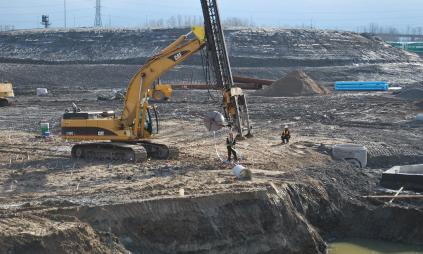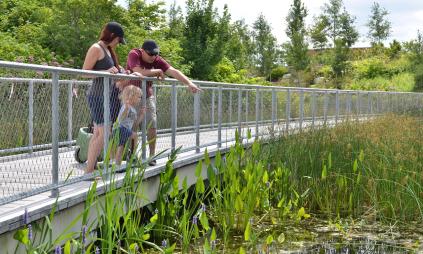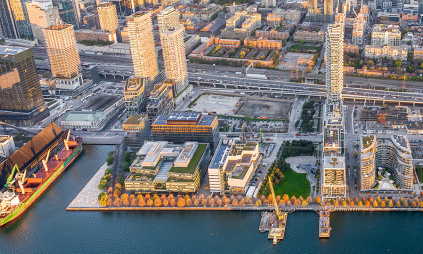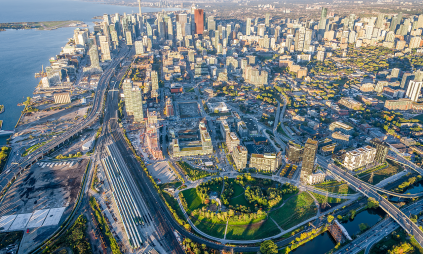Green & Resilient Communities
Waterfront Toronto is committed to making the city’s waterfront both a national and global model for sustainability and resilience – it’s at the heart of our mandate and approach.
In every project we deliver, we strive to create a lakeshore that supports a thriving city while sustaining healthy ecosystems. By guiding the creation of a greener built environment and supporting the health of our city, we’re creating a waterfront where people and nature thrive together.
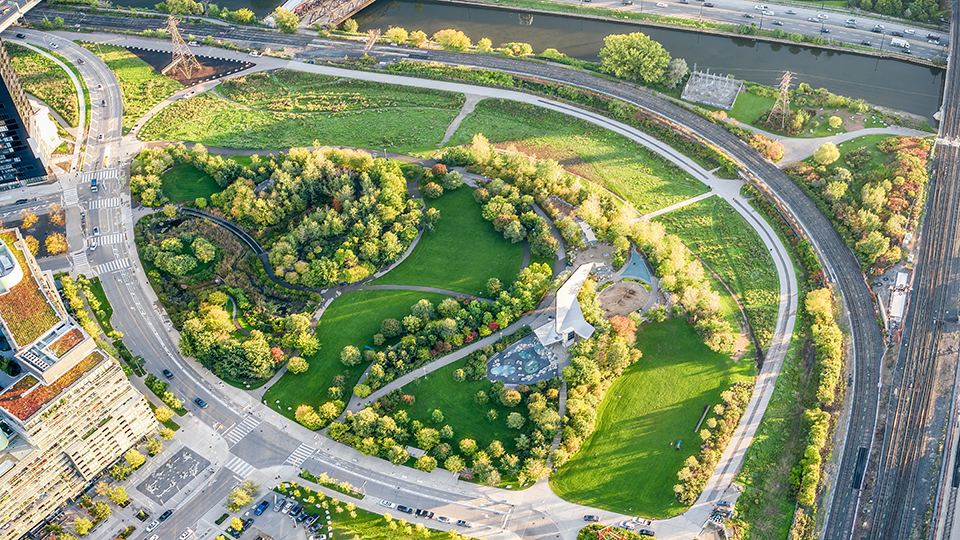
Green Building Requirements (v3 2021)
Download the PDF
Resilience and Innovation Framework (2017)
Read the PDF
Guiding our Work
We use two core documents to ensure delivery of green and resilient communities along the waterfront: The Waterfront Toronto Resilience and Innovation Framework for Sustainability and the Green Building Requirements.
The Resilience and Innovation Framework for Sustainability (or the Framework) was introduced in 2017 as the next chapter in our continually evolving approach to green city-building, building on the success of the 2005 Sustainability Framework. The Framework is the foundation upon which Waterfront Toronto will deliver on its mandate for Environmentally and Socially Responsible Prosperity. It establishes a vision for how to create lasting social, economic and environmental benefits through waterfront revitalization and sets out the process through which our built, social and natural systems will support a Climate Positive community.
To ensure development achieves this vision, all Waterfront Toronto projects must meet the ambitious targets advanced by our Green Building Requirements (GBRs). Demonstrative of our ambition to constantly evolve and innovate, we released version 3 of the GBRs in 2021 to continue promoting market transformation and widespread adoption of progressive green building standards. To this end, the GBRs include six performance areas:
- Achieving Tier 3 of the Toronto Green Standard
- Resilience
- Energy and Total Carbon Emissions
- Sustainable Sites and Water
- Transportation
- Sustainable Materials and Solid Waste
Infrastructure
From stormwater management and flood protection to digital connectivity and affordable housing, Waterfront Toronto is creating next-generation environmental and social infrastructure that adds value by future-proofing the city while optimizing form and function to serve multiple uses.
Being able to effectively manage and treat stormwater – created by rain and melting snow – is critical to safely guide runoff, prevent flooding and ensure pollutants in the water are removed prior to being discharged into Lake Ontario. Waterfront Toronto is constructing an extensive and integrated stormwater management system that will manage stormwater for the East Bayfront, West Don Lands, and Keating Channel communities.
Delivering resilient communities also requires sophisticated flood protection infrastructure. To protect the West Don Lands from flooding, we worked with Toronto and Region Conservation (TRCA) and Infrastructure Ontario to deliver a large berm (or Flood Protection Landform) and widen the Kingston Subdivision Bridge over the Don River.
We are also actively working to reduce flood risk in the Port Lands. Renaturalizing the mouth of the Don River is a magnificent city building project that will transform the existing mouth of the Don River into a healthier, more natural outlet and deliver critical infrastructure. This complex project will remove the risk of flooding to 240 hectares (593 acres) of urban land to the east and south of the river enabling development of the surrounding area.
In addition to physical infrastructure, Waterfront Toronto is committed to enhancing the social resilience of our communities, including digital access and affordable housing options. To this end, we put access and inclusion to digital infrastructure at the heart of our technology decisions and mandate that 20% of new housing units must be affordable.
Initiatives
A thriving tree canopy
Trees play a central role on our new waterfront. Not only do they provide welcome shade, they help clean the air and improve the environment. Over the course of the waterfront revitalization project, we’ll be planting about 34,000 new trees that will help define our waterfront and restore the natural beauty of our shoreline. Waterfront Toronto is aiming to cover 30-35% of our revitalization area with trees – contributing to the City’s plan to increase Toronto’s tree canopy to 30-40% over the next 50 years.
We’re working to save existing trees and making smart choices when planting new trees by choosing native species. Native species generally require much less water to thrive and do not introduce the risk of ecosystem disruption. They are also tolerant to our climate and levels of urban pollution.
We’re also taking measures to enhance terrestrial habitat including creating favourable conditions for migratory birds. All of these efforts will help to reduce the heat island effect, purify the air, improve stormwater management, and add beauty to our new neighbourhoods.
Aquatic Habitat
Restoring habitat is a vital part of waterfront revitalization. In every project we deliver, Waterfront Toronto strives for a win-win—a lakeshore that’s more vibrant and inviting for humans and one that sustains diverse and resilient ecosystems. Great habitat not only supports wildlife, it protects the health of the environment we all share.
Waterfront Toronto is one of the founding members of Aquatic Habitat Toronto (AHT), a consensus based partnership between agencies with a vested interest in the improvement of aquatic habitat on Toronto’s waterfront. Through our partnership with AHT, we are fulfilling our commitment to improving aquatic habitat in all projects we undertake at the water’s edge. Information about our strategy for Aquatic Habitat improvements can be found in our Parks and Public Space Framework.
Transit First
Transit is vital to a vibrant and connected waterfront. Waterfront Toronto is committed to implementing transit in advance of or in tandem with development. Developing and constructing bike paths and pedestrian links between the waterfront neighbourhoods and the rest of the city is also a key consideration in all development plans. Waterfront Toronto’s transit strategy and other initiatives will reap environmental benefits now and for generations to come.
Each new waterfront community will be fully served by transit through a plan focused on streetcars in dedicated right-of-ways and light rail. Virtually every residence will be within five minutes of a transit stop, reducing the need for private vehicles as a primary means of transport to and from home or work in waterfront neighbourhoods.
Buildings
The revitalization plan for Toronto’s waterfront is intended to position the city as a world leader in creating sustainable communities, with buildings and neighbourhoods that are among the greenest in the world. To this end, we use the Green Building Requirements to ensure the delivery of low carbon, high performance buildings that incorporate smart technologies, physical and social resilience, and passive design strategies.

